HVDC Converter Cooling System with a Phase Change Dispersion
Abstract
:1. Introduction
2. Technical Requirements
2.1. Phase Change Dispersion Requirements
- The PCD needs to be stable against phase separation. Generally, this is achieved through a good surfactant system and a small particle size.
- The PCD needs to have a small degree of supercooling as the heat absorption within the heat sink needs to be considered. The heat needs to be removed from the system by the re-cooling system and supercooling would mean that the temperature difference within the re-cooling unit would decrease and consequently so would the cooling power. To reduce the degree of supercooling, nucleating agents need to be added to the PCD. The PCD used in this investigation had nucleating agents added to it and the supercooling degree was lowered to 2 K. For further details, see the discussion in [27].
- Since the HVDC system operates at 800 kV it is required that the PCD has a low electrical conductivity of approximately 0.3 S cm, this low electrical conductivity needs to be continually maintained through deionising. The PCD therefore needs to be compatible with ion exchange resins, meaning that there cannot be surface wetting of the resin surface by the organic PCM dispersed phase. Furthermore, no ionic surfactants and no electrically conductive PCM can be accepted.
- From the PCD known in the literature, most use paraffin as the PCM dispersed phase due to existing know-how of the interactions between paraffin and classical surfactant systems. However, on the industrial-scale, paraffin show partial freezing out, which forms thin layers of the PCM on the surface of heat exchangers and piping. Additionally, removal, maintenance and cleaning of paraffin systems requires very strong solvents at high temperatures. Therefore, it is necessary for the PCM to be from another organic class other than paraffin. The PCD used in this investigation has two fatty acid esters as the PCM, as described in [27].
- PCD are known for their high specific heat capacities within the desired melting range. In [28], it is shown that this may be up to a factor of two or three compared to water at the same pressure drop.
- The PCD needs to have a low pressure drop and low viscosity to ensure that it is pumpable. However, low pressure drops (low viscosities) will make it technically unfeasible to make a PCD that can last for years in such a system (small particle sizes ensure greater stability, but also increases the viscosity). Therefore, a re-dispersing step will need to be inserted. This re-dispersion will occur when the PCD is flowing and ensure a small and narrow particle size is continuously achieved.
- The global heat transfer coefficients (h) for the PCD should be at least the same as those for water under the same operational conditions.The requirements 1–5 were discussed in the first paper of the series [27] and this paper will focus on requirements 6 and 7; investigating the heat transfer behaviour and the pressure drop of the PCD in comparison to water.
2.2. Standard HVDC Cooling System Requirements
3. Materials and Methods
3.1. Phase Change Dispersion
3.2. Heat Sink Design
3.3. Experimental Setup
3.3.1. Test-Rig
| Block material | Copper EN CW004A |
| Thermal conductivity @ 50 () | 390 W m K |
| Diameter of the heat transfer area (d) | 135 mm |
| Thickness of the block (e) | 65 mm |
| Number of heating cartridges | 6 per side (12 in total) |
| Dimensions of heating cartridges | x = 10 mm L = 40 mm, 230 V |
| Maximum heating power (P) | 250 W per cartridge, 1.5 kW per side, 3 kW in total |
| Temperature sensor position from inlet () | 0 = inlet, 0.07, 0.36, 0.64, 0.93 and 1 = outlet |
3.3.2. Sensors and Data Acquisition
3.3.3. Quantities of Interest
3.3.4. Experimental Procedure
4. Results and Discussion
4.1. Heat Losses
4.2. Heat Transfer Performance
4.3. Pressure Drop
5. Conclusions
Author Contributions
Funding
Institutional Review Board Statement
Informed Consent Statement
Data Availability Statement
Acknowledgments
Conflicts of Interest
Abbreviations
| High Voltage Direct Current | |
| Alternating Current | |
| High Voltage | |
| Metal Oxide Semiconductor Field Effect Transistor | |
| Insulated-gate Bipolar Transistor | |
| Computational fluid dynamics | |
| Direct Current | |
| Heat transfer fluid | |
| Polyvinylidene fluoride | |
| Polytetrafluoroethylene | |
| Phase Change Dispersion | |
| Phase Change Material | |
| PCM | Phase Change Material |
| PCD | Phase Change Dispersion |
| Total | Total |
| Water | Water |
| Melting | Melting |
| el | Electrical |
| max | Maximum |
| losses | Losses |
| in | Inlet |
| out | Outlet |
| PCM | Phase Change Material |
| wall | Wall |
| bulk | Bulk |
| calc | Calculated |
| exp | Experimentally obtained |
| a | Temperature difference at the inlet between heat sink and source |
| b | Temperature difference at the outlet between heat sink and source |
| h | Global heat transfer coefficient (W m K) |
| Specific heat capacity (J kg K) | |
| a | Thermal diffusvitiy (m) |
| m | Mass (g) |
| d | Diameter (m) |
| P | Heat input (W) |
| L | Length (m) |
| e | Thickness (m) |
| x | Height (m) |
| Thermal resistance (K W) | |
| A | Area (m) |
| Mass flow rate (kg s) | |
| Heat flux (W m) | |
| Heat transfer rate (W) | |
| Electrical conductivity (S m) | |
| Density (kg m) | |
| Thermal conductivity (W m K) | |
| Viscosity (Pa s) | |
| Temperature difference (K) | |
| Pressure drop (Pa) | |
| Phase change enthalpy (kJ kg) | |
| Mass content (-) |
References
- IEA. Global Energy Review 2020; IEA: Paris, France, 2020. [Google Scholar]
- May, T.W.; Yeap, Y.M.; Ukil, A. Comparative evaluation of power loss in HVAC and HVDC transmission systems. In Proceedings of the 2016 IEEE Region 10 Conference (TENCON), Singapore, 22–25 November 2016; IEEE: New York, NY, USA, 2016; pp. 637–641. [Google Scholar]
- Nguyen, M.H.; Saha, T.K. Power loss evaluations for long distance transmission lines. In Proceedings of the Australian Geothermal Energy Conference, Brisbane, Australia, 11–13 November 2009; pp. 307–312. [Google Scholar]
- Fernández-Guillamón, A.; Das, K.; Cutululis, N.; Molina-Garcia, A. Offshore Wind Power Integration into Future Power Systems: Overview and Trends. J. Mar. Sci. Eng. 2019, 7, 399. [Google Scholar] [CrossRef] [Green Version]
- Bhandari, V.S.; Kulkarni, S.H. Optimization of heat sink for thyristor using particle swarm optimization. Results Eng. 2019, 4, 100034. [Google Scholar] [CrossRef]
- Kwon, B.; Foulkes, T.; Yang, T.; Miljkovic, N.; King, W.P. Air jet impingement cooling of electronic devices using additively manufactured nozzles. IEEE Trans. Compon. Packag. Manuf. Technol. 2019, 10, 220–229. [Google Scholar] [CrossRef]
- Meghdir, A.; Benabdallah, T.; Dellil, A.Z. Impact of geometry of electronic components on cooling improvement. Int. J. Heat Transf. 2019, 37, 167–178. [Google Scholar] [CrossRef] [Green Version]
- Wiriyasart, S.; Hommalee, C.; Naphon, P. Thermal cooling enhancement of dual processors computer with thermoelectric air cooler module. Case Stud. Therm. Eng. 2019, 14, 100445. [Google Scholar] [CrossRef]
- Murshed, S.M.S.; Nieto de Castro, C. A critical review of traditional and emerging techniques and fluids for electronics cooling. Renew. Sustain. Energy Rev. 2017, 78, 821–833. [Google Scholar] [CrossRef]
- Khalaj, A.H.; Halgamuge, S.K. A Review on efficient thermal management of air-and liquid-cooled data centers: From chip to the cooling system. Appl. Energy 2017, 205, 1165–1188. [Google Scholar] [CrossRef]
- Sparrow, E.M.; Chevalier, P.W.; Abraham, J.P. The design of cold plates for the thermal management of electronic equipment. Heat Transf. Eng. 2006, 27, 6–16. [Google Scholar] [CrossRef]
- Kandlikar, S.G.; Hayner, C.N. Liquid cooled cold plates for industrial high-power electronic devices—Thermal design and manufacturing considerations. Heat Transf. Eng. 2009, 30, 918–930. [Google Scholar] [CrossRef]
- Nilsson, S.; de Mattos Tenório, A.R.; Sen, S.; Taylor, A.; Xu, S.; Zhao, G.; Song, Q.; Lei, B. Application Examples of the Thyristor Controlled Series Capacitor. In Flexible AC Transmission Systems: FACTS; Springer International Publishing: Cham, Switzerland, 2019; pp. 1–59. [Google Scholar]
- Darin, S.; Jankowski, N.; Bar-Cohen, A. Two-Phase Fluid Selection for High-temperature Automotive Platforms; Technical Report; Army Research Laboratory: Adelphi, MD, USA, 2012. [Google Scholar]
- Ghoghaei, M.S.; Mahmoudian, A.; Mohammadi, O.; Shafii, M.B.; Mosleh, H.J.; Zandieh, M.; Ahmadi, M.H. A review on the applications of micro-/nano-encapsulated phase change material slurry in heat transfer and thermal storage systems. J. Therm. Anal. Calorim. 2020, 1–24. [Google Scholar] [CrossRef]
- Chai, L.; Shaukat, R.; Wang, L.; Wang, H.S. A review on heat transfer and hydrodynamic characteristics of nano/microencapsulated phase change slurry (N/MPCS) in mini/microchannel heat sinks. Appl. Therm. Eng. 2018, 135, 334–349. [Google Scholar] [CrossRef] [Green Version]
- Alva, G.; Lin, Y.; Liu, L.; Fang, G. Synthesis, characterization and applications of microencapsulated phase change materials in thermal energy storage: A review. Energy Build. 2017, 144, 276–294. [Google Scholar] [CrossRef]
- Wang, F.; Lin, W.; Ling, Z.; Fang, X. A comprehensive review on phase change material emulsions: Fabrication, characteristics, and heat transfer performance. Sol. Energy Mater. Sol. Cells 2019, 191, 218–234. [Google Scholar] [CrossRef]
- Morimoto, T.; Kumano, H. Flow and heat transfer characteristics of phase change emulsions in a circular tube: Part 1. Laminar flow. Int. J. Heat Mass Transf. 2018, 117, 887–895. [Google Scholar] [CrossRef]
- Morimoto, T.; Sugiyama, M.; Kumano, H. Experimental study of heat transfer characteristics of phase change material emulsions in a horizontal circular tube. Appl. Therm. Eng. 2021, 188, 116634. [Google Scholar] [CrossRef]
- Ma, F.; Chen, J.; Zhang, P. Experimental study of the hydraulic and thermal performances of nano-sized phase change emulsion in horizontal mini-tubes. Energy 2018, 149, 944–953. [Google Scholar] [CrossRef]
- Vasile, V.; Necula, H.; Badea, A.; Revellin, R.; Bonjour, J.; Haberschill, P. Experimental study of the heat transfer characteristics of a paraffin-in-water emulsion used as a secondary refrigerant. Int. J. Refrig. 2018, 88, 1–7. [Google Scholar] [CrossRef]
- Chen, J.; Zhang, P. Preparation and characterization of nano-sized phase change emulsions as thermal energy storage and transport media. Appl. Energy 2017, 190, 868–879. [Google Scholar] [CrossRef]
- Wang, F.; Fang, X.; Zhang, Z. Preparation of phase change material emulsions with good stability and little supercooling by using a mixed polymeric emulsifier for thermal energy storage. Sol. Energy Mater. Sol. Cells 2018, 176, 381–390. [Google Scholar] [CrossRef]
- Ho, C.; Lin, K.H.; Rashidi, S.; Toghraie, D.; Yan, W.M. Experimental study on thermophysical properties of water-based nanoemulsion of n-eicosane PCM. J. Mol. Liq. 2021, 321, 114760. [Google Scholar] [CrossRef]
- Yang, L.; Huang, J.N.; Zhou, F. Thermophysical properties and applications of nano-enhanced PCMs: An update review. Energy Convers. Manag. 2020, 214, 112876. [Google Scholar] [CrossRef]
- Fischer, L.; Mura, E.; O’Neill, P.; von Arx, S.; Worlitschek, J.; Qiao, G.; Li, Q.; Ding, Y. Thermophysical properties of a phase change dispersion for cooling around 50 °C. Int. J. Refrig. 2020, 119, 410–419. [Google Scholar] [CrossRef]
- Fischer, L.; Maranda, S.; Stamatiou, A.; von Arx, S.; Worlitschek, J. Experimental investigation on heat transfer with a Phase Change Dispersion. Appl. Therm. Eng. 2019, 147, 61–73. [Google Scholar] [CrossRef]
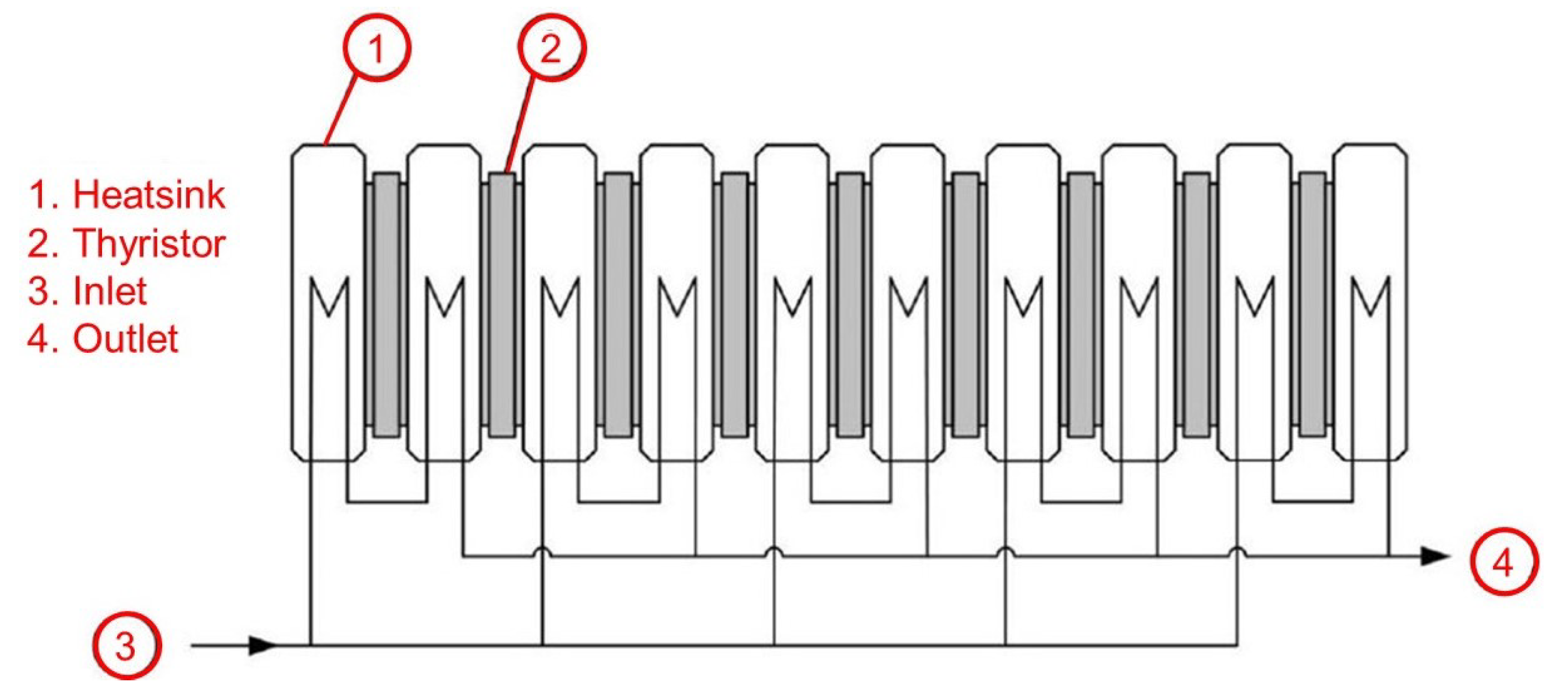


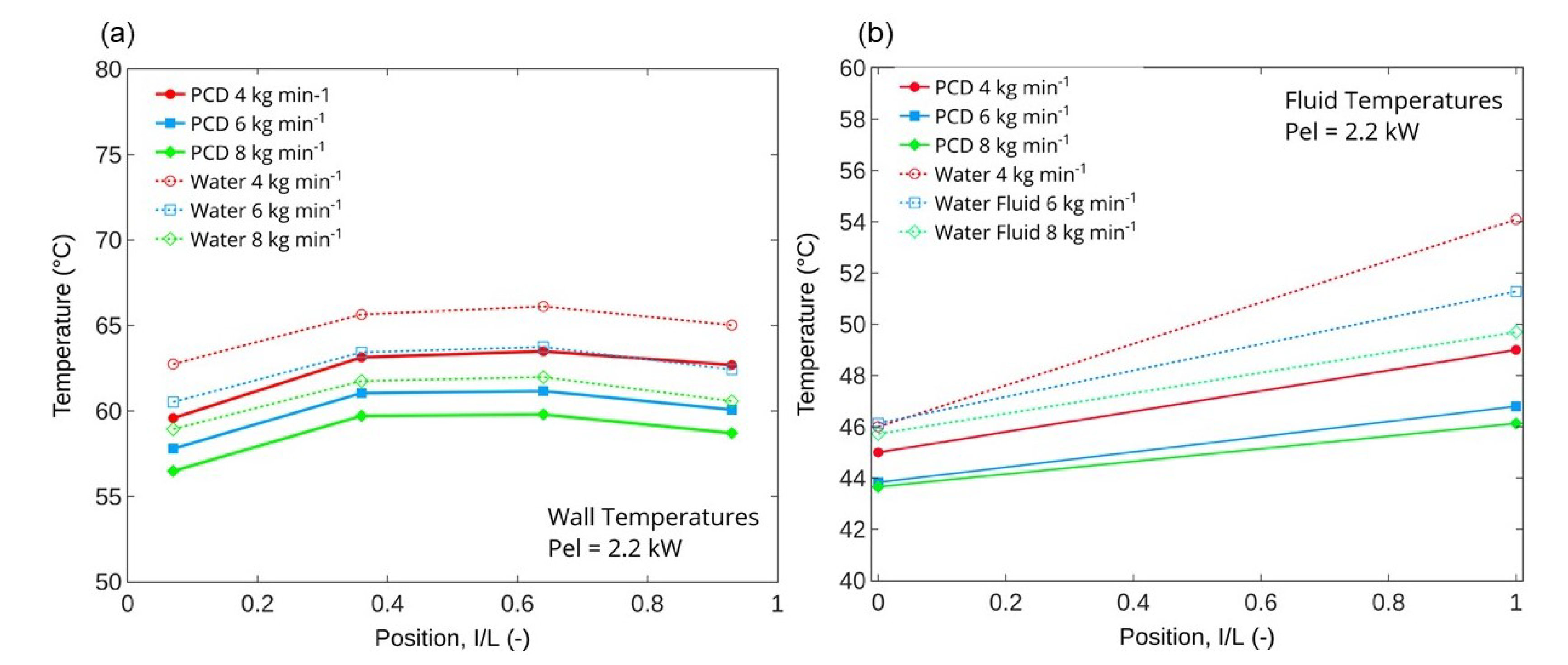
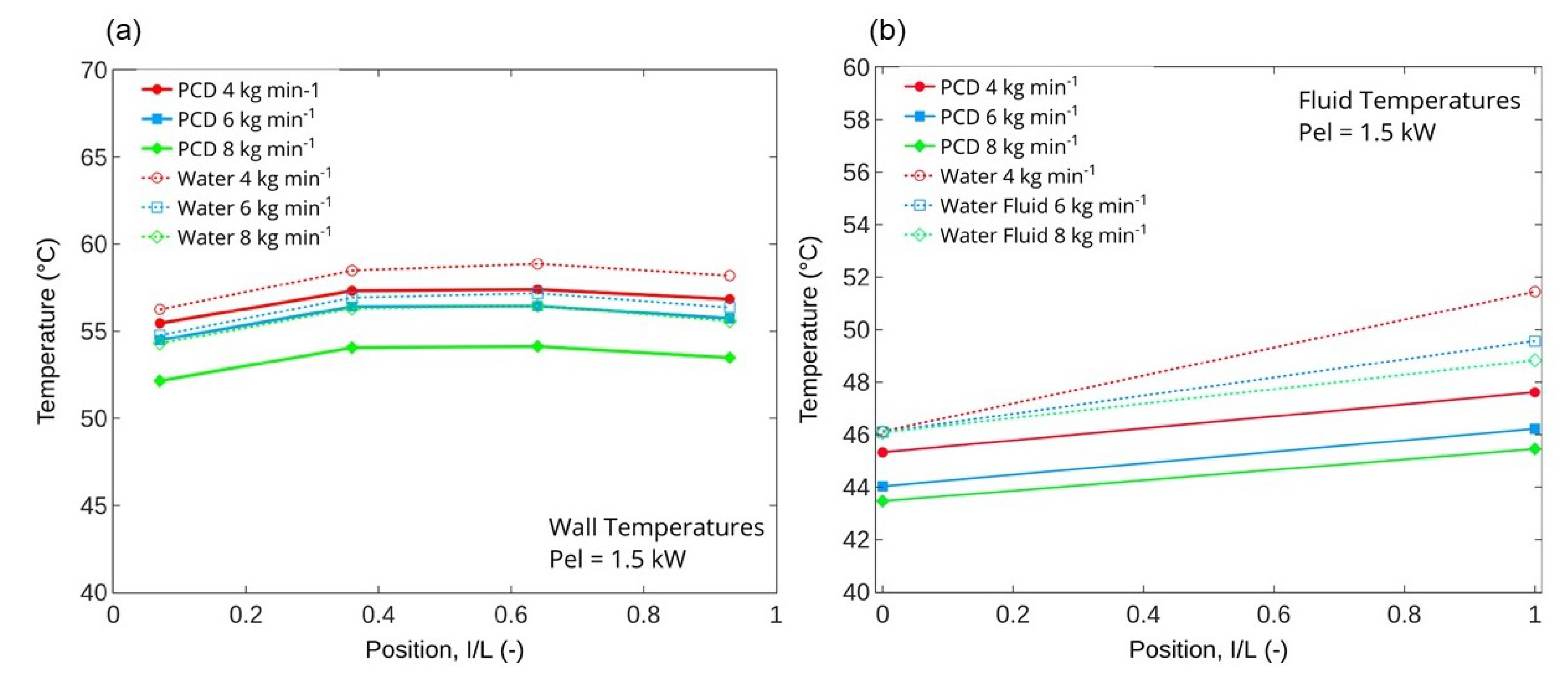
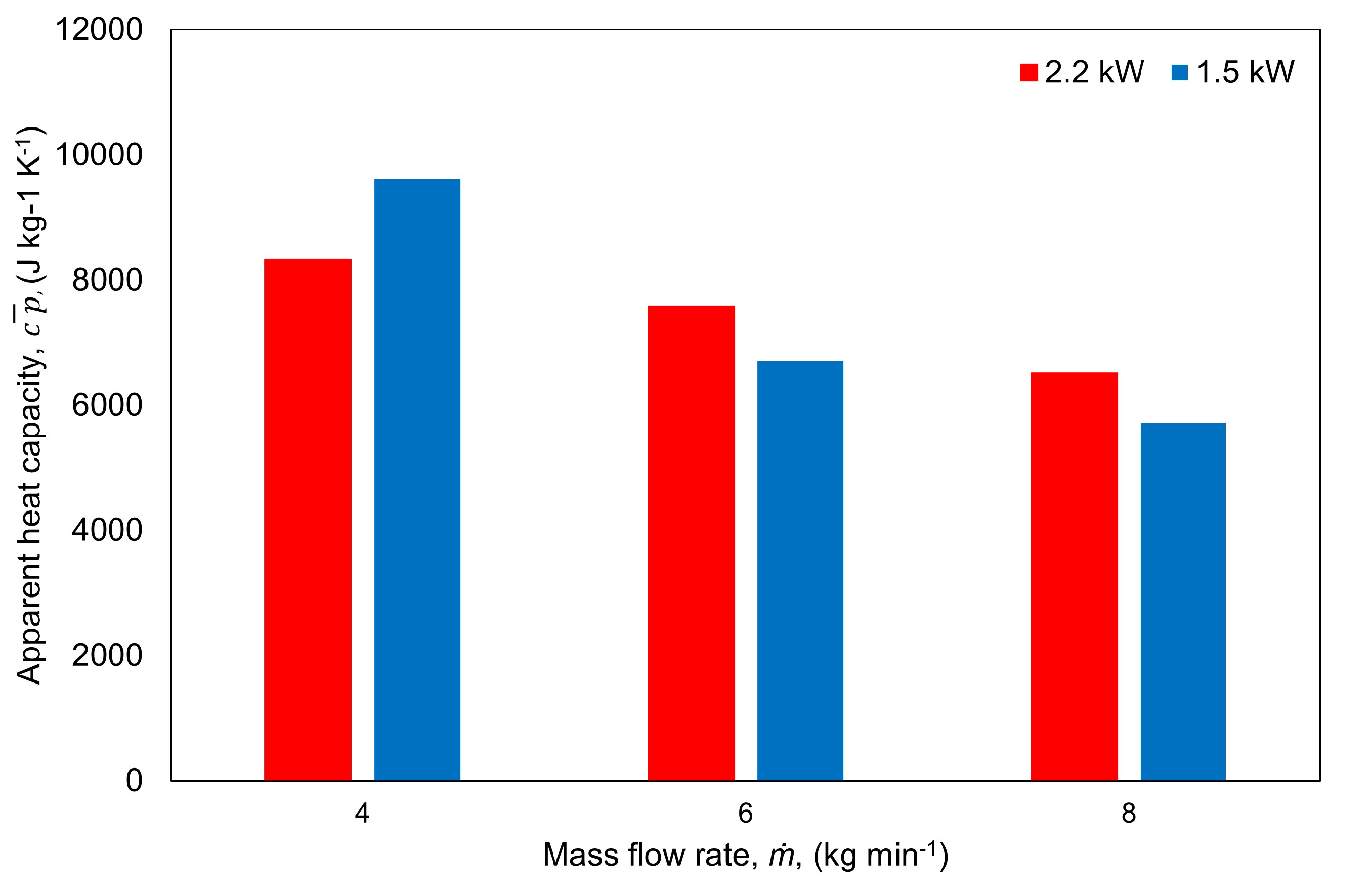
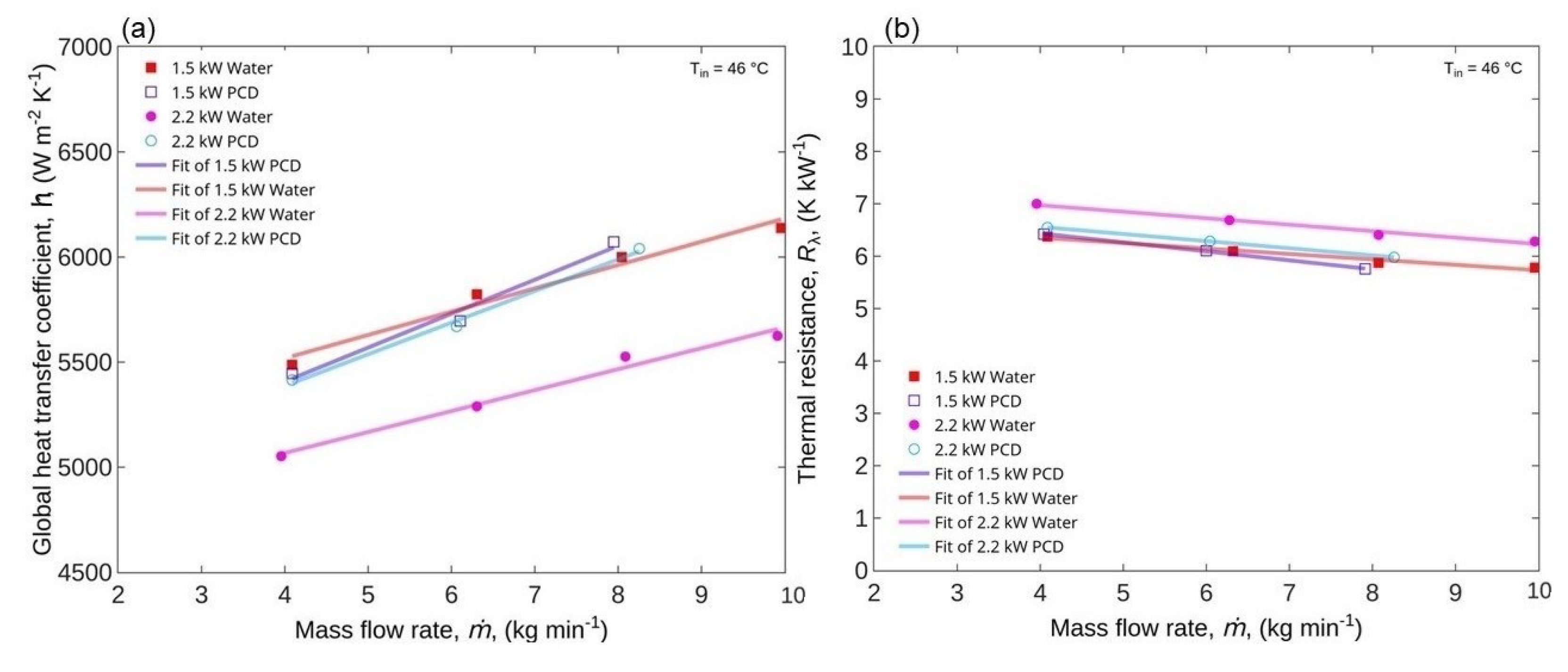
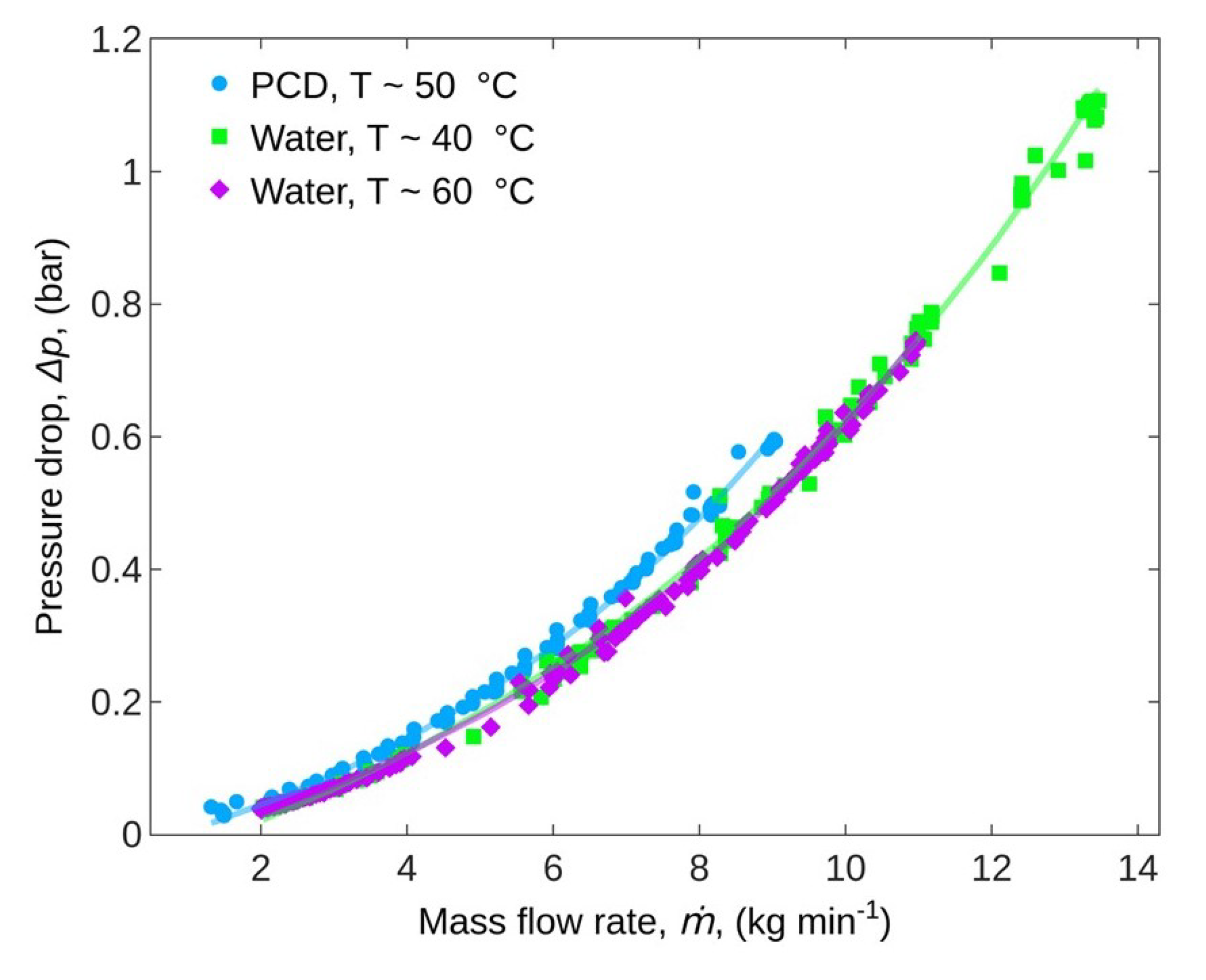
| Specification of Industrial Installation | Unit | Value |
|---|---|---|
| Inlet temperature of the cooling liquid into the heat sink | C | 46 |
| Specified outlet temperature of the cooling liquid from the entire converter valve | C | 55.3 |
| Temperature increase of water as HTF | K | 9.3 |
| Definition of optimum temperature for the phase change | C | 47.5–50 |
| Considered flow rate of the cooling liquid water | L min | 8 |
| Pressure drop of water (8 L min, 25 C) | mbar | 390 |
| Thyristor core temperature | C | 90 |
| Thyristor surface temperature | C | 65 |
| Heat sink surface temperature | C | 62 |
| Diameter of the heat exchange surface at the heat sink (cylindrical) | m | 0.134 |
| Thyristor dimension | inch | 5 |
| Heat transfer surface area (both sides together) | m | 0.0282 |
| Thyristor heat source | W | 1700–2200 |
| Specific heat flux (for 2200 W, 1100 W from each side) | W m | 78,000 |
| Mass of the heat sink | kg | 3.2 |
| Temperature increase with 8 L min and 1100 W from each side (2.2 kW in total) | K | 3.94 |
| Property and Conditions | Symbol | Unit | PCM | Water | PCD |
|---|---|---|---|---|---|
| Specific heat capacity @ 25 C | kJ kg K | 1.17 | 4.185 | 3.69 | |
| Specific heat capacity @ 60 C | kJ kg K | 2.2 | 4.183 | 3.78 | |
| Density @ 25 C | kg m | 902 | 997 | 988 | |
| Density @ 60 C | kg m | 830 | 983 | 980 | |
| Phase change enthalpy during melting | kJ kg | 202 | 333 | 34 | |
| Thermal conductivity @ 25 C | W m K | 0.231 | 0.608 | 0.529 | |
| Thermal conductivity @ 60 C | W m K | 0.206 | 0.651 | 0.561 | |
| Viscosity at 100 1/s and @ 25 C | mPa s | - | 0.89 | 4.2 | |
| Viscosity at 100 1/s and @ 60 C | mPa s | - | 0.47 | 2.1 | |
| Thermal diffusivity @ 25 C | a | m s | 1.50 × 10 | 1.46 × 10 | 1.50 × 10 |
| Thermal diffusivity @ 60 C | a | m s | 1.10 × 10 | 1.58 × 10 | 1.50 × 10 |
| Material of the Heat Sink | AlMgSiO |
|---|---|
| Thermal conductivity of the heat sink material () | 185 W m K |
| Electrical conductivity of the heat sink material () | 28.6 × 6 S m |
| Web thickness | 2.65 mm |
| Channel width | 3.6 mm |
| Angle of the webs to the side | 75 |
| Angle of the webs with respect to each other | 30 |
| Channel height of the centre side | 1.6 mm |
| Channel height of the surface side | 2.4 mm |
| Length of the cooling field (inlet to outlet) | 118 mm |
| Width of the cooling field | 130 mm |
| Porosity | 0.576 |
| Free cross sectional area | 299.5 mm |
| Equipment | Manufacturer | Type | Range | Uncertainty |
|---|---|---|---|---|
| Fluid temperature sensor (T101, T102) | Roth + Co AG | PT100 1/3 DIN | −50–+200 C | ±0.03 C |
| Wall temperature sensor (T103, T104, T105 and T106) | Roth + Co AG | PT100 1/3 DIN | −50–+200 C | ±0.03 C |
| Differential pressure () | Endress + Hauser | Deltabar S PMD75 | 0–40 bar | ±0.0025 bar |
| Coriolis flowmeter (Fl01) | Endress + Hauser | Promass F 83, Type 4x | 0–6500 kg h | ±9.0 kg h |
| Electrical power (P) | Jumo GmbH | TYA 201 | 0–4 kW | ±0.02 kW |
| Data acquisition | National instruments | NI 9126 | Sampling rate: 1 Hz | 14 bit precision |
Publisher’s Note: MDPI stays neutral with regard to jurisdictional claims in published maps and institutional affiliations. |
© 2021 by the authors. Licensee MDPI, Basel, Switzerland. This article is an open access article distributed under the terms and conditions of the Creative Commons Attribution (CC BY) license (http://creativecommons.org/licenses/by/4.0/).
Share and Cite
Fischer, L.; Mura, E.; Qiao, G.; O’Neill, P.; von Arx, S.; Li, Q.; Ding, Y. HVDC Converter Cooling System with a Phase Change Dispersion. Fluids 2021, 6, 117. https://doi.org/10.3390/fluids6030117
Fischer L, Mura E, Qiao G, O’Neill P, von Arx S, Li Q, Ding Y. HVDC Converter Cooling System with a Phase Change Dispersion. Fluids. 2021; 6(3):117. https://doi.org/10.3390/fluids6030117
Chicago/Turabian StyleFischer, Ludger, Ernesto Mura, Geng Qiao, Poppy O’Neill, Silvan von Arx, Qi Li, and Yulong Ding. 2021. "HVDC Converter Cooling System with a Phase Change Dispersion" Fluids 6, no. 3: 117. https://doi.org/10.3390/fluids6030117
APA StyleFischer, L., Mura, E., Qiao, G., O’Neill, P., von Arx, S., Li, Q., & Ding, Y. (2021). HVDC Converter Cooling System with a Phase Change Dispersion. Fluids, 6(3), 117. https://doi.org/10.3390/fluids6030117







